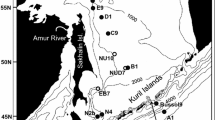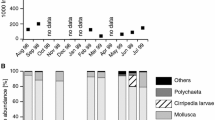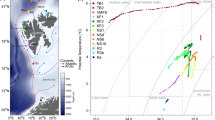Abstract
Neocalanus flemingeri, Neocalanus plumchrus, Neocalanus cristatus and Eucalanus bungii are large and dominant mesozooplankton occurring throughout the subarctic Pacific. They are an important trophic link and transporter of organic matter to the mesopelagic zone. Vertical distributions of these copepods were investigated from March to October 2000 in the Oyashio region of the western subarctic Pacific. Neocalanus plumchrus and N. flemingeri were distributed in the surface layer (0–50 m) and N. cristatus and E. bungii in the subsurface layer (50–100 m). However, when examined in detail, clear seasonal and vertical differences were observed. Neocalanus plumchrus was concentrated in the top 20 m from late April to the end of July, and N. flemingeri showed a little deeper distribution from May to July. Neocalanus cristatus showed a deeper distribution than that of grazing individuals of E. bungii from April to early July, but grazing individuals of E. bungii (C3–C6) showed a deeper distribution than that of N. cristatus from the end of July to October. Early copepodites of E. bungii were distributed much shallower than late copepodite stages and overlapped with copepodites of N. plumchrus and N. flemingeri. These results suggest that the four species of large copepods have established habitat segregation by season, vertical distribution and food resource partitioning in the Oyashio region as well as other regions of the North Pacific.











Similar content being viewed by others
References
Banse K, English DC (1999) Comparing phytoplankton seasonality in the eastern and western subarctic Pacific and the western Bering Sea. Prog Oceanogr 43:235–288
Booth BC, Lewin J, Lorenzen CJ (1993) Temporal variation in the structure of autotrophic and heterotrophic communities in the subarctic Pacific. Prog Oceanogr 32:57–99
Cullen JJ (1995) Status of the iron hypothesis after the open-ocean enrichment experiment. Limnol Oceanogr 40:1336–1343
Dagg MJ (1993) Sinking particles as a possible source of nutrition for the calanoid copepod Neocalanus cristatus in the subarctic Pacific Ocean. Deep Sea Res I 40:1431–1445
Dagg M, Strom S, Liu H (2009) High feeding rates on large particles by Neocalanus flemingeri and N. plumchrus, and consequences for phytoplankton community structure in the subarctic Pacific Ocean. Deep Sea Res I 56:716–726
Goldblatt RH, Mackas DL, Lewis AG (1999) Mesozooplankton community characteristics in the NE subarctic Pacific. Deep Sea Res II 46:2619–2644
Harrison PJ, Tsuda T, Saito H, Whitney F, Tadokoro K (2004) North Pacific east–west similarities and differences in nutrient and phytoplankton dynamics. J Oceanogr 60:93–117
Holm-Hansen O, Lorenzen CJ, Holmes RN, Strickland JDH (1965) Fluorometric determination of chlorophyll. J Cons Perm Int Explor Mer 30:3–15
Kobari K, Ikeda T (1999) Vertical distribution, population structure and life cycle of Neocalanus cristatus (Crustacea: Copepoda) in the Oyashio region, with notes on its regional variations. Mar Biol 134:683–696
Kobari K, Ikeda T (2001a) Life cycle of Neocalanus flemingeri (Crustacea: Copepoda) in the Oyashio region, western subarctic Pacific, with notes on its regional variations. Mar Ecol Prog Ser 209:243–255
Kobari K, Ikeda T (2001b) Ontogenetic migration and life cycle of Neocalanus plumchrus (Crustacea: Copepoda) in the Oyashio region, with notes on its regional variations in body size. J Plankton Res 23:287–302
Kobari T, Shinada A, Tsuda A (2003a) Functional roles of interzonal migrating mesozooplankton in the western subarctic Pacific. Prog Oceanogr 57:279–298
Kobari T, Tadokoro K, Shiomoto A, Hashimoto S (2003b) Geographical variations in prosome length and body weight of Neocalanus copepods in the North Pacific. J Oceanogr 59:3–10
Kobari T, Steinberg DK, Ueda A, Tsuda A, Silver MW, Kitamura M (2008) Impact of ontogenetically migrating copepods on downward carbon flux in the western subarctic Pacific Ocean. Deep Sea Res II 55:1648–1660
Kuriyama M, Nishida S (2006) Species diversity and niche-partitioning in the pelagic copepods of the family Scolecitrichidae (Calanoida). Crustaceana 79:293–317
Kusaka A, Ono T, Azumaya T, Kasai H, Oguma S, Kawasaki Y, Hirakawa K (2009) Seasonal variations of oceanographic conditions in the continental shelf area off the eastern Pacific coast of Hokkaido, Japan. Oceanogr Japan 18:135–156 (in Japanese with English abstract)
Machida JR, Tsuda A (2010) Dissimilarity of species and forms of the planktonic Neocalanus copepods using mitocondorial COI, 12S, nuclear ITS, and 28S gene sequence. PLoS ONE 5(4):e10278. doi:10.1371/journal.pone.0010278
Mackas DL, Tsuda A (1999) Mesozooplankton in the eastern and western subarctic Pacific: community structure, seasonal life histories, and interannual variability. Prog Oceanogr 43:335–363
Mackas DL, Sefton H, Miller CB, Raich A (1993) Vertical habitat partitioning by large calanoid copepods in the oceanic subarctic Pacific during spring. Prog Oceanogr 32:259–294
Martin JH, Fitzwater SE (1988) Iron deficiency limits phytoplankton growth in the north-east Pacific subarctic. Nature 331:341–343
Mehlum F, Hunt GL, Klusek Z, Decker MB (1999) Scale-dependent correlations between the abundance of Brunnich’s guillemots and their prey. J Anim Ecol 68:60–72
Miller CB, Clemons MJ (1988) Revised life history analysis for large grazing copepods in the subarctic Pacific Ocean. Prog Oceanogr 20:293–313
Miller CB, Terazaki M (1989) Life histories of Neocalanus flemingeri and Neocalanus plumchrus in the Sea of Japan. Bull Plankton Soc Japan 36:27–41
Miller CB, Frost BW, Batchelder HP, Clemons MJ, Conway RE (1984) Life histories of large, grazing copepods in a subarctic ocean gyre: Neocalanus plumchrus, Neocalanus cristatus and Eucalanus bungii in the northeast Pacific. Prog Oceanogr 13:201–243
Moku M, Kawaguchi K, Watanabe H, Ohno A (2000) Feeding habits of three dominant myctophid fishes, Diaphus theta, Stenobrachius leucopsarus and S. nannochir, in the subarctic and transitional waters of the western North Pacific. Mar Ecol Prog Ser 207:129–140
Pennak RW (1943) An effective method of diagramming diurnal movements of zooplankton organisms. Ecology 24:405–407
Rothschild BJ, Osborn TR (1988) Small-scale turbulence and planktonic contact rates. J Plankton Res 10:465–474
Saito H, Kasai H, Kashiwai M, Kawasaki Y, Kono T, Taguchi S, Tsuda A (1998) General description of seasonal variations of nutrients, chlorophyll-a, and netplankton biomass along A-line transect, Oyashio region western subarctic Pacific, from 1990 to 1994. Bull Hokkaido Natl Fish Res Inst 62:1–62
Saito H, Tsuda A (2000) Egg production and early development of large subarctic copepods Neocalanus cristatus, N. plumchrus and N. flemingeri. Deep-Sea Res 47:2141–2158
Saito H, Tsuda A, Kasai H (2002) Nutrient and plankton dynamics in the Oyashio region of the western subarctic Pacific Ocean. Deep Sea Res II 49:5463–5486
Saito H, Tsuda A, Nojiri Y, Aramaki T, Ogawa H, Yoshimura T, Imai K, Kudo I, Nishioka J, Ono T, Suzuki K, Takeda S (2009) Biogeochemical cycling of N and Si during the mesoscale iron-enrichment experiment in the western subarctic Pacific (SEEDS-II). Deep Sea Res II 56:2852–2862
Shinada A, Ikeda T, Ban S, Tsuda A (2001) Seasonal dynamics of planktonic food chains in the Oyashio region, western subarctic Pacific. J Plankton Res 23:1237–1247
Shoden S, Ikeda T, Yamaguchi A (2005) Vertical distribution, population structure and lifecycle of Eucalanus bungii (Copepoda: Calanoida) in the Oyashio region, with notes on its regional variations. Mar Biol 146:497–511
Smith SL, Vidal J, Lane PVZ (1983) Processes and resources of the Bering Sea Shelf: Data Report PDR, 83-017
Suzuki R, Ishimaru T (1990) An improved method for the determination of phytoplankton chlorophyll using N,N-dimethylformamide. J Oceanogr 46:190–194
Takahashi K, Kuwata A, Saito H, Ide K (2008) Grazing impact of the copepod community in the Oyashio region of the western subarctic Pacific Ocean. Prog Oceanogr 78:222–240
Tatebe H, Yasuda I, Saito H, Shimizu Y (2010) Horizontal transport of the calanoid copepod Neocalanus in the North Pacific: the influences of the current system and the life history. Deep Sea Res I 57:409–419
Terazaki M, Tomatsu C (1997) A vertical multiple opening and closing plankton sampler. J Adv Mar Sci Tech Soc 3:127–132
Tsuda A, Saito H, Kasai H (1998) Annual variation of occurrence and growth in the life cycles of Neocalanus flemingeri and N. plumchrus (Calanoida, Copepoda) in the western subarctic Pacific. “Aha Huliko’a”, biotic impacts of extratropical climate variability in the Pacific. Proc Hawaiian winter workshop, pp 61–68
Tsuda A, Saito H, Kasai H (1999) Life histories of Neocalanus flemingeri and Neocalanus plumchrus in the western subarctic Pacific. Mar Biol 135:533–544
Tsuda A, Saito H, Kasai H (2001a) Life history strategies of subarctic copepods Neocalanus flemingeri and N. plumchrus, especially concerning lipid accumulation patterns. Plankton Biol Ecol 48:52–58
Tsuda A, Saito H, Kasai H (2001b) Geographical variation of body size of Neocalanus cristatus, N. plumchrus and N. flemingeri in the subarctic Pacific and its marginal seas: implication of the origin of large form N. flemingeri in Oyashio area. J Oceanogr 57:341–352
Tsuda A, Saito H, Kasai H (2004) Life histories of Eucalanus bungii and Neocalanus cristatus (Calanoida: Copepoda) in the western subarctic Pacific. Fish Oceanogr 13:10–20
Tsuda A, Saito H, Nishioka J, Ono T (2005) Mesozooplankton responses to iron-fertilization in the western subarctic Pacific (SEEDS2001). Prog Oceanogr 64:237–251
Tsuda A, Saito H, Nishioka J, Ono T, Noiri Y, Kudo I (2006) Mesozooplankton response to iron enrichment during the diatom bloom and bloom decline in SERIES (NE Pacific). Deep Sea Res II 53:2281–2296
Tsuda A, Takeda S, Saito H, Nishioka J, Kudo I, Nojiri Y, Suzuki K, Uematsu M, Wells ML, Tsumune D, Yoshimura T, Aono T, Aramaki T, Cochlan WP, Hayakawa M, Imai K, Isada T, Iwamoto Y, Johnson KW, Kameyama S, Kato S, Kiyosawa H, Kondo Y, Levasseur M, Machida R, Nagao I, Nakagawa F, Nakanishi T, Nakatsuka S, Narita A, Noiri Y, Obata H, Ogawa H, Oguma K, Ono T, Sakuragi T, Sasakawa M, Sato M, Shimamoto A, Takata H, Trick CG, Watanabe YY, Wong CS, Yoshie Y (2007) Evidence for the grazing hypothesis: grazing reduces phytoplankton responses of the HNLC ecosystem to iron enrichment in the western subarctic Pacific (SEEDS II). J Oceanogr 63:983–994
Tsuda A, Saito H, Machida RJ, Shimode S (2009) Meso- and microzooplankton responses to an in situ iron fertilization experiment (SEEDS-II) in the northwest subarctic Pacific. Deep Sea Res II 56:2767–2778
von Vaupel Klein JC (1998) Cases of niche-partitioning and of habitat-segregation in pelagic marine calanoids of the genus Euchirella (Crustacea: Copepoda). Zoologische Verhandelingen Leiden 323:383–400
Acknowledgments
We wish to thank the captains and crews of the FRVs Tankai Maru, Hokko Maru and our colleagues onboard during the cruises. We are also grateful to Drs. C. B. Miller, M.J. Dagg, K. Takashashi and an anonymous referee for his helpful comments and discussions. Dr. S. Shimode helped with production of figures. This study was supported by the Japan Society for the Promotion of Science (#20241003).
Author information
Authors and Affiliations
Corresponding author
Rights and permissions
About this article
Cite this article
Tsuda, A., Saito, H. & Kasai, H. Vertical distributions of large ontogenetically migrating copepods in the Oyashio region during their growing season. J Oceanogr 70, 123–132 (2014). https://doi.org/10.1007/s10872-013-0214-4
Received:
Revised:
Accepted:
Published:
Issue Date:
DOI: https://doi.org/10.1007/s10872-013-0214-4




